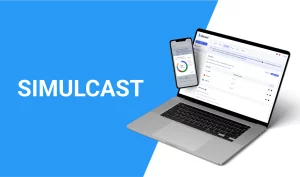Simulcasting is the technique of streaming to multiple destinations at once.
This video tutorial will show you how to simulcast to Facebook, YouTube, Twitch, or any other RTMP destinations from the Dacast app.
As a final result, you should have your stream playing directly on those platforms’ feeds and anywhere you’ve embedded your Dacast live channel.
Let’s go!

Simulcasting: How to Stream to Multiple Destinations – Dacast, Facebook & More
Simulcasting is the technique of streaming to multiple destinations at once. This guide will show you how to simulcast to Facebook, YouTube, Twitch or any other RTMP destination from the Dacast app. As a final result, you should have your stream playing directly on those platforms’ feeds and anywhere you’ve embedded your Dacast live channel. [...]
(0:05 – 0:21)
Welcome to the Dacast streaming platform. In this video, we’ll introduce you to the simulcast feature of our web-based application. What is simulcasting? The term simulcast is a shorthand term for simultaneous broadcast.
(0:22 – 0:47)
It describes simultaneously broadcasting a video via multiple delivery channels. In the context of live online video, simulcast streaming refers to streaming live on multiple distribution platforms at once. For example, you may want to simulcast on your own website, YouTube, Facebook, LinkedIn, Twitch, TikTok, and other popular social sites.
(0:47 – 1:11)
Simulcast streaming is about sharing the same content in multiple locations to increase access and viewership to the content. How to set up simulcasting? Log in to your Dacast account, then select a live stream channel. Go to the Engagement tab of your live stream channel, scroll down and look, Simulcast.
(1:11 – 1:25)
Then click the Connect button to select new stream destinations. You have several destinations available from Dacast. Facebook, YouTube, Twitch, any RTMP platform.

(1:26 – 1:47)
YouTube Go on YouTube, log in to your account if you’re not connected, click on your profile, then click on your YouTube studio. Once you are on your YouTube studio, you can see different icons to go live at the top right. Click on it.
(1:47 – 1:58)
Once your studio is displayed, please check your stream settings. You can find the stream key there. Copy and paste this stream key to your Dacast live stream engagement tab.
(2:01 – 2:13)
Click on the Connect button to display the model below. Once YouTube has been chosen as a destination, save your choice so it will be added. Your live stream is now connected to YouTube.
(2:13 – 2:33)
As soon as you begin streaming, using your usual encoder, you’ll also be streaming on YouTube. Facebook Once logged in to your Facebook page or profile, click on Live Video from your home page. You can choose between Go Live and Create Live Video Event.
(2:34 – 2:43)
For this example, you can click on Go Live. Now choose Streaming Software. You can see and copy your stream key.
(2:43 – 2:57)
Copy and paste this stream key to your Dacast live stream engagement tab. Click on the Connect button to display the model below. Once Facebook has been chosen as a destination, save your choice so it will be added.
(2:59 – 3:17)
Your live stream is now connected to Facebook. As soon as you’ll be streaming, using your usual encoder, you’ll also be streaming on Facebook. Twitch Once logged in to your Twitch account, click on your profile to access your creator dashboard.
(3:18 – 3:34)
You can now click on Settings on the left menu. You can now click on the Stream submenu, and you’ll be able to copy your primary stream key. Copy and paste this stream key to your Decast live stream engagement tab.
(3:34 – 3:49)
Click on the Connect button to display the model below. Once Twitch has been chosen as a destination, save your choice so it will be added. Your live stream is now connected to Twitch.
(3:50 – 4:00)
Feel free to contact our support team directly to discuss your specific needs. We are here to help, and we will walk you through any technical questions you may have.

 Stream
Stream Connect
Connect Manage
Manage
 Events
Events Business
Business Organizations
Organizations Entertainment and Media
Entertainment and Media API
API Tools
Tools Learning Center
Learning Center Support
Support Support Articles
Support Articles

















